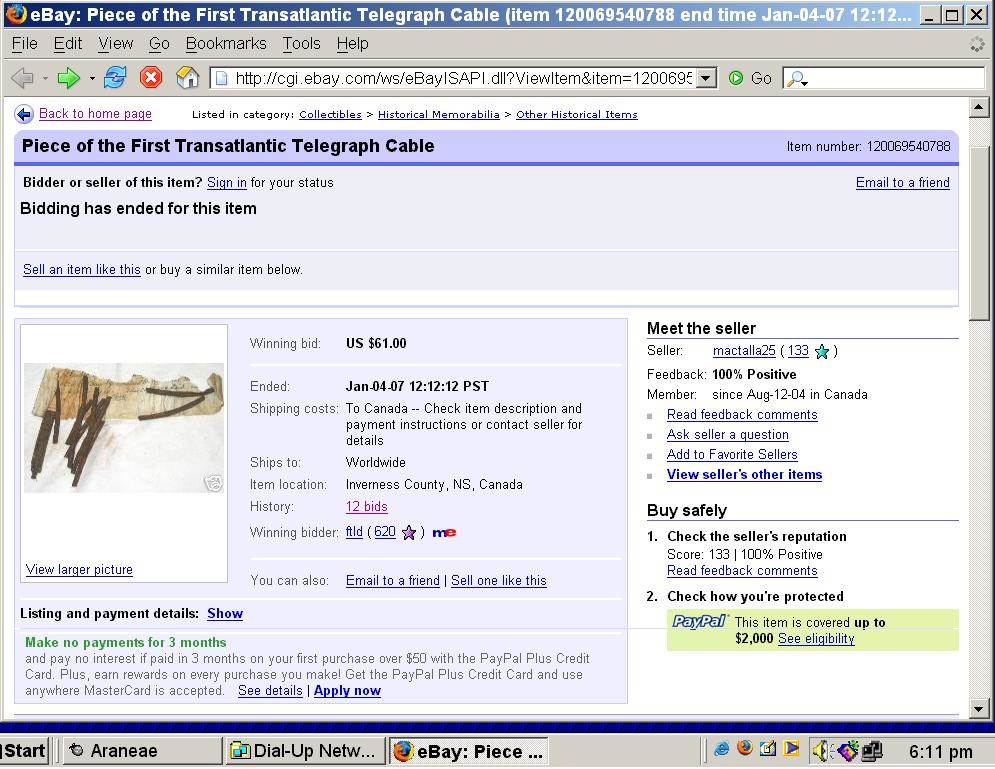
Transatlantic Telegraph
New York, Newfoundland and London Telegraph Company
Cabot Strait Telegraph Cable 1856
Part of the first transatlantic telecommunication service
In its time the telegraph was as exciting as the Web is today.
Almost overnight, it was said, the world was shrunk to a global
village. The masters of the arcane knowledge of telegraphy had
high salaries, there was tension between private investment and
government regulation, there was concern over security, a rush
to invent peripheral devices (Edison made his first fortune from a
ticker tape machine), and many investors got their fingers burned.
— Denis Weaire, Physics Department, Trinity College, Dublin, Ireland
Cecil Powell Memorial Lecture
European Physical Society General Meeting, Budapest, 2002
http://www.europhysicsnews.org/articles/epn/pdf/2002/05/epn02504.pdf
Europhysics News (2002) Vol. 33 No. 5
Undersea Cables in Recent News

Russian Presence Near Undersea Cables Concerns U.S.
New York Times October 25, 2015
Aspy Bay Victoria County Nova Scotia
GPS location: 46°56’32″N 60°27’46″W
Also see: John Cabot 1497 memorial Aspy Bay
 Aspy Bay historic site at dawn
Aspy Bay historic site at dawn
Photographed at 6:25am on 3 September 2003

A surviving length of undersea electric telegraph cable
on display at the Aspy Bay historic site
Photographed on 3 September 2003
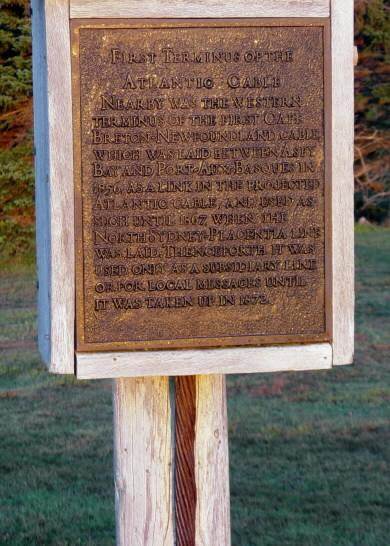
Photographed on 3 September 2003
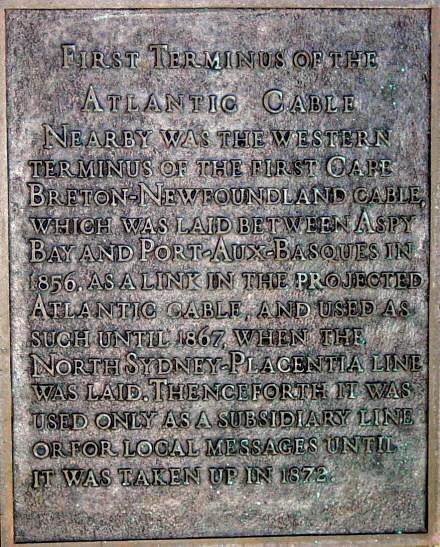
Photographed on 24 June 2003
Note: The plaque states that the cable “was taken up in 1872.”
I doubt this is true. The cable was taken out of service in 1872,
but almost certainly it was just abandoned and left on the bottom
of Cabot Strait. It would have been very expensive to pick up this
long cable from the ocean depths, and whatever small value there
might have been in the the salvaged copper would have offset only
a small part of the removal cost. Because design and manufacturing
techniquesforunderseatelegraphcablesinthe1850swereprimitive,
these cables had only a short working life. These early cables
deteriorated rapidly, and after ten to fifteen years on the ocean floor,
the maintenance and repair costs increased and the cable reliability
decreased to a point that often required the installation of a new cable.
By 1872, the Cabot Strait cable laid in 1856 was sixteen years old,
likely near the end of its useful working life (which quite possibly
was the main reason for taking it out of service at that time) and
it could not be relaid in another location.
ICS (30 June 2003)
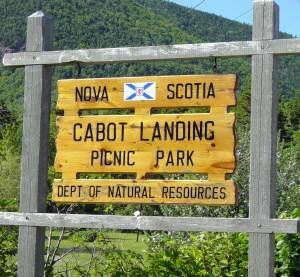 This sign marks the entrance.
This sign marks the entrance.
Photographed on 24 June 2003

Cabot Strait telegraph cable historic site
Photographed on 24 June 2003
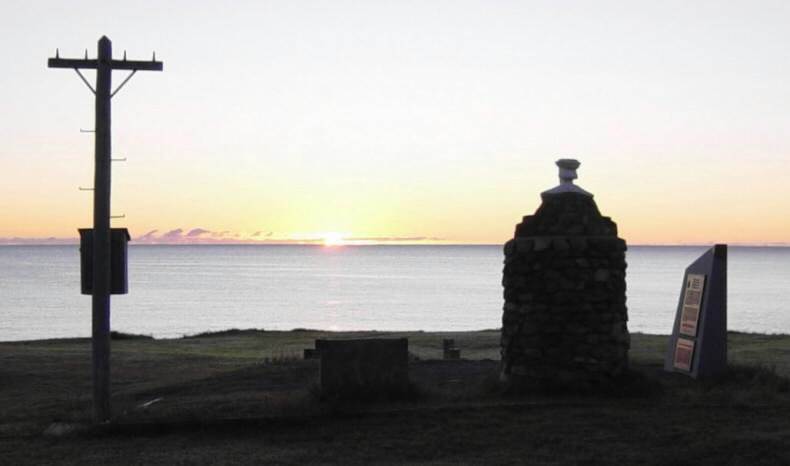 Sunrise at Aspy Bay
Sunrise at Aspy Bay
Photographed at 6:24am on 3 September 2003
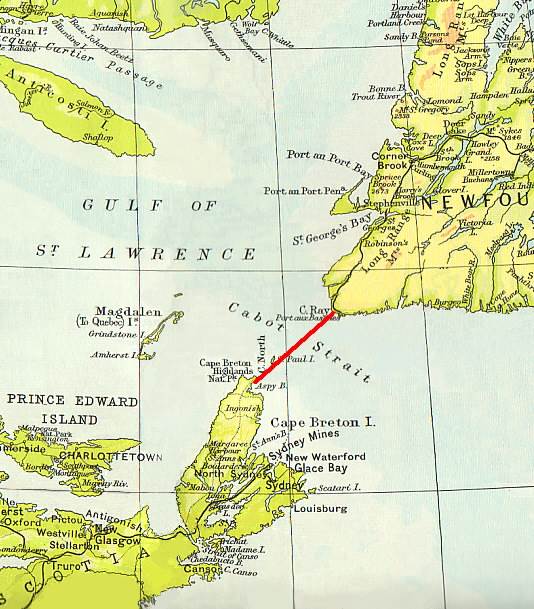
Map showing the location of of the 1856 electric telegraph cable
across Cabot Strait, connecting Newfoundland with Cape Breton Island
— thus connecting London with New York, and Istanbul with New Orleans
The railways shown on the map, in Newfoundland and Nova Scotia,
did not exist in 1856. They were built decades after the
Cabot Strait telegraph cable was put into operation.
1858 Map showing the whole route of the Atlantic Cable
and the trans-Atlantic electric telegraph, London to New York
http://www.atlantic-cable.com/Article/1858Leslies/0821f.jpg
Map showing the location of Cabot Strait telegraph cable 1856
To adjust the map, use the pan and zoom controls in the upper left corner.
…The history of the initial failures and final success in laying the Atlantic cable has been well told by Mr.Charles Bright (seeThe Story of the Atlantic Cable, London,1903). The first cable laid in1857 broke on the 11thof August during laying. The second attempt in 1858 was successful, but the cable completed on the 5thof August 1858 broke down on the 20thof October 1858, after 732messages had passed throughit. The third cable laid in1865 was lost on the 2ndof August 1865, but in 1866 a final success was attained and the1865 cable also recovered and completed…
— Encyclopedia Britannica 1911, volume 9, page 187
http://www.gutenberg.org/files/35092/35092-h/35092-h.htm
1897 Map of Underwater Telegraph Cables in the Vicinity of Nova Scotia

Map of submarine telegraph cables in the northwest Atlantic Ocean
by the International Telegraph Bureau, Bern, 1897
The 1856 cable across Cabot Strait is not shown
on this map. It was abandoned in the 1870s.
History of the Atlantic Cable… (an excellent history)
After one abortive attempt in the summer of 1855, Cyrus Field’s New York, Newfoundland and London Telegraph Company succeeded in laying a submarine cable across the Cabot Strait in1856. Also completed that year was the Company’s trans-Newfoundland overland line. The entire operation, which established a telegraph link all the way between NewYork and St.John’s, cost over a million dollars…
Excerpted and adapted from:
The Atlantic Cable,
published by Minister, Department of Tourism, Culture and Recreation
Historic Resources Division, Government of Newfoundland and Labrador
http://www.ewh.ieee.org/reg/7/diglib/library/hearts-content/historic/provsite.html
IEEE (Eye-triple-E): the Institute of Electrical and Electronics Engineers, Inc.
The St. John’s to Cape Ray overland telegraph line followed the south coast of Newfoundland, allowing supplies to be delivered by ship to construction sites. The construction of this telegraph line employed 600men, and was completed in the fall of1856.
The first message was sent on 1 October 1856 to Baddeck, Cape Breton from St. John’s merchant J.S.Pitts. This message travelled along the overland telegraph line across Newfoundland from St.John’s to CapeRay, then across Cabot Strait through the underwater electric telegraph cable, then along the overland telegraph line across Cape Breton from Aspy Bay to Baddeck.
Excerpted and adapted from:
History of Clarenville: Telegraph and Telephone Companies
http://web.archive.orghttp://www.k12.nf.ca/discovery/Commmunities/acdrom/clarenville/telegraph.html
One of the important challenges of the 1850s and 1860s was to get European news to New York as fast as possible. The New York newspapers were willing to pay enormous amounts of money for news from Europe if it could be delivered to them even a few hours ahead of the arrival of the mail steamship from England.
Frederick Gisborne saw the potential of St. John’s as a transfer point for messages arriving by steamship from Europe to be telegraphed to the United States, but only (atleast for the time being) in the sense that if a NewYork bound ship dropped off the news in Newfoundland, and it could then be telegraphed to NewYork, and the news would arrive at least 48hours ahead of the ship. The newspapers would pay big money for that advantage.
So Gisborne moved to Newfoundland, and began to promote a connection by electric telegraph along the south coast of Newfoundland and across Cabot Strait to Cape Breton.
But St. John’s was not a port of call for ships on their way to New York, and Gisbourne had a novel solution for that. The big steamships passed near Cape Race, and he proposed that they toss a barrel containing the messages over the side, where it would be recovered by a waiting small boat and rushed ashore to Trepassey, where the news would be forwarded by telegraph. Believe it or not, this system eventually became operational, and New York newspapers carried numerous items of European news with the byline “Via Cape Race”.
Excerpted and adapted from:
Isambard Kingdom Brunel (1806-1859)
by Ross Peters, Faculty of Engineering and Applied Science, Memorial University of Newfoundland
http://www.engr.mun.ca/~gpeters/5101brun.html
In 1859 (after the failure of the 1858 transatlantic telegraph cable) the Associated Press of New York stationed a boat at Cape Race to intercept transatlantic steamships on their way to Halifax and New York. News and messages from Europe, thrown overboard from the steamers in water-tight canisters, were picked up and telegraphed to North American newspapers from the telegraph office at Cape Race. This practice continued up to the completion of the first successful transatlantic cable in August 1866 and was acknowledged in North American newspapers by the byline “Via Cape Race”.
Excerpted and adapted from:
History of Clarenville: Telegraph and Telephone Companies
http://www.k12.nf.ca/discovery/Commmunities/acdrom/clarenville/telegraph.html
The Cabot Strait Telegraph Cable
Seven Years at the Heart of Transatlantic News
1859-1866
NEWS WESTBOUND (from Europe to North America)
The receipts from the Newfoundland telegraph lines throughout this period of hope deferred (1858-1866) were very small and very precarious.
In 1859 a news boat was placed at Cape Race by the Associated Press to intercept ocean steamers; the first ship met was the S.S.Vigo, of the Inman Line.
The public constantly saw the heading in English and American papers, “Via Cape Race,” but few had any idea of those daring trips of bold John Murphy to catch the outward and homeward bound steamers; considering the imminent peril of landing and launching boats from such a wild spot, it is marvellous how much news was sent in this extraordinary way.
Source:
footnote 2, page 641 of “A History of Newfoundland from the English, Colonial, and Foreign Records”
by Daniel Woodley Prowse, Q.C., Judge of the Central District Court of Newfoundland
published 1895
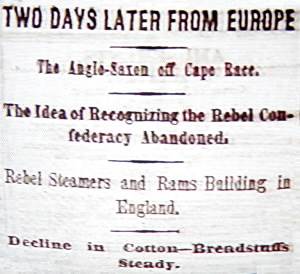
“The Anglo-Saxon off Cape Race”
Newspaper clipping, 1862
(believed to be from the New York Times)
When the S.S. (Steam Ship) Anglo-Saxon departed Europe it had the latest European news on board. As the ship passed Cape Race without stopping or even slowing down, a package (barrel) was tossed overboard to be retrieved by the A.P. news boat.
While the transatlantic steamship Anglo-Saxon continued westward at top speed, the news barrel was picked up at sea and brought ashore by the news boat at Cape Race and immediately telegraphed to the Associated Press in New York – over the one-wire electric telegraph line owned and operated by the New York, Newfoundland and London Telegraph Company. This extraordinary effort got the latest European news to New York, and all North America, days ahead of the ship’s arrival at its destination. The heading “Two Days Later From Europe” means this brief news item — brief because of the per word cost of telegrams from Newfoundland to New York — contained European news two days later (more up-to-date) than was previously available in North America.
From 1859 to 1866, “Via Cape Race” in a newspaper headline was the equivalent of the “BreakingNews” graphic we now see flashed on our television screens when important up-to-date news has arrived. Along the way, all of this news travelled through the Cabot Strait telegraph cable.
Note: Part of this newspaper clip conveys the information that shipyards in England are building steamships and rams for the Confederacy. This refers to efforts by the Confederate Navy, during the American Civil War, to obtain warships from builders in Great Britain.
“…The Confederate agent Bulloch extended his ambitions when he contracted with Birkenhead shipbuilders, Laird and Sons, to construct two turreted ironclad rams. Bulloch based the rams upon the ideas of Capt. Cowper Coles of the Royal Navy, an outspoken British ironclad designer. They were impressive ships displacing 1,423tons (light) and were 224feet long. Their iron hulls had ram bows supporting two turrets carrying 220-pounder Armstrong guns; lighter guns were mounted on raised forecastles and quarterdecks. Bark sailing rigs gave them range; powerful twin-screw engines combined with ram bows gave them ability to fight the most imposing Union ships… Bulloch was disappointed by the loss of the Laird rams…”
Source –
The Diplomats Who Sank a Fleet: The Confederacy’s Undelivered European Fleet
and the Union Consular Service by Kevin J. Foster
http://www.archives.gov/publications/prologue/2001/fall/confederate-fleet-1.html
This news item travelled through
the Cabot Strait telegraph cable
on its way to the United States.
See:
TransAtlantic Telegraph Companies
http://ns1758.ca/tele/telegraph02.html
(On April 27, 1863, about 240 people died when the S.S. Anglo-Saxon
ran aground on the Avalon Peninsula near Cape Race.)
…Cape Race is also the terminal point eastward of that remarkable system of telegraph lines which extends throughout the whole of the United States and the British possessions [inNorth America]. The Americans delight in the telegraph, and use it continually for every sort of purpose, and in a way and extent that Europeans have no notion of. From this lonely rock, standing out in the Atlantic amid fogs and storms, European news is flashed to the most distant parts of America. From Boston to New Orleans the newspapers have it, print it, and the intelligence is old when the ship arrives at New York, three or four days after passing Cape Race…
From “Cape Race, Newfoundland” in
The Illustrated London News London, England, 24 August 1861
http://cti.library.emory.edu/iln/browse.php?id=iln39.1104.060
The Cabot Strait Telegraph Cable
Seven Years at the Heart of Transatlantic News
1859-1866
NEWS WESTBOUND (from Europe to North America)
“By the steamer City of Washington we have received NewYork journals to the 18thult. and a short telegram from Cape Race to the 22nd…”
The Illustrated London News London, England, 2 November 1861
http://cti.library.emory.edu/iln/browse.php?id=iln39.1115.127
Interpretation:— The steamship City of Washington departed New York on 18 October 1861. As was usual for all ships departing New York for any distant port, it was carrying the latest copies of New York newspapers (“journals”), brought on board at the last minute before the ship cast loose its lines and steamed away from the dock.
This was the way the news was distributed in those days. Each ship carried copies of newspapers from its departure point, and when the ship arrived at its destination – in England or France or Brazil or Australia or wherever – those newspapers were hurriedly taken ashore and carried to the local newspapers for reprinting, and to the local electric telegraph office for transmission around the country, bringing to the local population the very latest news available from NewYork, and thus from the United States. Ifthe ship took fifteen days to reach its destination, that meant that the latest United States news available there would be fifteen days old (a fact that today we have great difficulty comprehending).
A steamship departing New York would normally take about ten days to arrive at Liverpool, England. When the ship arrived at Liverpool, the New York news would be taken ashore and quickly telegraphed throughout the United Kingdom and all Europe. This was the latest news available, but it was ten days old.
After the Cabot Strait telegraph cable was laid in 1856, there was a continuous electric telegraph line from New York to Cape Race. This means that messages could be sent in either direction between Cape Race and New York in a couple of hours.
After the steamship City of Washington departed New York on 18October 1861, on its way to England, it took about four days to arrive near Cape Race. Asthe City of Washington steamed past Cape Race, the latest news carried on the ship was then four days old, but, at the Cape Race telegraph office, the latest news from New York was only two or three hours old.
If the ship could get this up-to-date news from the Cape Race telegraph, it would arrive in England with news only six days old, instead often. Cape Race could cut four days from the age of the news as it arrived in England and all Europe. But the ship could not stop at Cape Race even for a few minutes to pick up this late news – there was no port or dock at Cape Race large enough for an ocean-going steamship, and anyway these transatlantic ships ran on tight schedules and would not take the time for even a brief stop in a port.
Remember, there was no radio in 1861; there was no way to send a message from Cape Race to any passing ship other than to write that message on paper, put the paper in an envelope, and carry that envelope in a small boat from Cape Race out to sea, find the ship, go alongside the ship, and somehow transfer the envelope from the small boat to the steamship – on the open sea, a dangerous undertaking at the best of times.
The demand for fresh news was so intense, that’s exactly what they did. Forseven years, from 1859 until 1866 – which includes the whole of the American Civil War, with all of its international complications such as the purchase by both sides (Union and Confederate) of war supplies and armaments from England, Scotland and France – scheduled passenger steamships passing Cape Race eastbound toward England would be handed a small package of the latest news telegraphed from New York.
After the steamship City of Washington departed New York on 18October 1861, on its way to England, it took about four days to arrive near Cape Race. As the City of Washington steamed past Cape Race on 22October, the latest news from New York – only two or three hours old by the new electric telegraph – was carried out to sea and handed on board the City of Washington.
This is what the London Illustrated News meant by “a short telegram from Cape Race to the 22nd.” When they went to press on November2nd, they had news from New York as recent as October 22nd – although it was only a “short telegram” (probably less than a thousand words) – there was at least a brief mention of any very important event that happened during those four days, from 18th and 22nd of October, after the City of Washington steamed away from New York.
During the entire American Civil War, 1861 to 1865, all news that reached Europe about what was happening in the United States and the Confederacy, was carried across the Atlantic by steamship. When Abraham Lincoln was assassinated in April 1865, this news reached England and Europe more than a week later.
On their way from New York to Cape Race,
– from the United States to Europe –
these late news items travelled through
the Cabot Strait telegraph cable.
“By the arrival of the steamer North American we have advices (news) to the evening of the 26thult. (26October 1861). Themost important event of the week has been the completion of the great continental telegraph line, uniting SanFrancisco with NewYork, and so with CapeRace, Newfoundland – aconnected line of 6000miles (10,000km], and the longest in the world. Itwas finished on the 25thult. (25October 1861)…”
The Illustrated London News London, England, 9 November 1861
http://cti.library.emory.edu/iln/browse.php?id=iln39.1116.134
The Cabot Strait telegraph cable was a crucial link in this
“great continental telegraph line…the longest in the world”
The first Transatlantic cable (1858) did not survive much beyond the exchange of greetings between Queen Victoria and the President of the United States. These messages were not as peremptory as is sometimes said. The Queen sent one of 99words. It took 16½hours to transmit it. No wonder that early telegraphic technologists were already very interested in compression; many codes were invented to achieve it.
The rapid failure of the first Atlantic cable was a commercial disaster and the improvement of its technology a demanding imperative. It suffered from electrical breakdown. LordKelvin made a rapid diagnosis and recommendation for the second attempt, which included using lower voltages than proposed, thicker insulation, and more sensitive detection. For this he developed an especially-sensitive mirror galvanometer.
The compelling force of Kelvin’s personality overcame the opposition of the ignorant and the amateurs, and a new system based on his ideas worked wonderfully well in1866. It made the amazing sum of one thousand pounds on its first day of operation. So he became rich and famous…
— Denis Weaire, Physics Department, Trinity College, Dublin, Ireland
Cecil Powell Memorial Lecture
European Physical Society General Meeting, Budapest, 2002
http://www.europhysicsnews.com/full/17/article4/article4.html
Europhysics News (2002) Vol. 33 No. 5
From 1859 to 1866, the Associated Press kept a newsboat at Cape Race to meet ocean liners passing by on their way from Europe so that news could be telegraphed to New York three days before the ship reached New York. These news items carried the byline “viaCapeRace”.
Dispatches for Europe via Cape Race
The steamship Arago which sailed from this port
on Saturday last, will touch at Cape Race, on
Wednesday evening, for dispatches for Europe.
Dispatches (messages) left with George Stoker,
telegraphic commercial agent, No. 145 Broadway,
up to noon of Wednesday, will be forwarded for
the Arago.
— New York Times, Monday, 23 July 1861
Interpretation:—
These were messages from New York (or
anywhere in the United States then connected
by electric telegraph) to be delivered as telegrams
soon as possible in Great Britain and Europe.
Then (1861) the fastest (shortest time) route for
a message from anywhere in the United States
to anywhere in Europe, was by electric telegraph
to Cape Race and then across the North Atlantic
Ocean by fast steamship. Of course, the actual
time required to get a message from origin to
destination depended greatly on the connection
at Cape Race between the telegraph system and
the steamship – a message could get from New
York or Washington to Cape Race in a couple of
hours, but then it had to wait until the next ship
came along headed east, a delay that could easily
extend to several days. However, the best time
from the eastern United States to Great Britain
could be as short as seven days if the message
happened to arrive at Cape Race just in time to
make the connection, and the ship made good
time across the ocean (no storms, no head winds,
no fog, no problems with the ship’s engines).
Messages (telegrams) taken to the telegraph
office at 145 Broadway, New York, were sent by
electric telegraph to Cape Race, where they
were written on paper and held awaiting the
arrival of the steamship. The telegraph line
between New York and Cape Race passed
through Boston, Calais (Maine), Saint John
and Moncton (New Brunswick), Amherst and
New Glasgow and Baddeck (Nova Scotia) to
Aspy Bay. From New York to Aspy Bay the
telegraph line was a single overhead iron wire
supported on poles. The telegraph line continued
through the new (1857) submarine (underwater)
cable across the Cabot Strait, between Cape
Breton Island and Newfoundland. From
Port-aux-Basques there was an overhead
one-wire telegraph line along Newfoundland’s
southern shore to Cape Race.
These transatlantic messages could be news
reports. They could be private communications
between two companies about purchases of grain
or industrial equipment or raw materials of all sorts.
They could be confidential government business
such as secret instructions to an ambassador, or
negotiations with a manufacturer of expensive
special equipment such as locomotives or cannons.
This system of transatlantic communication – the
connection at Cape Race between the North
American telegraph system and transatlantic
shipping services, both eastbound and
westbound – remained in full operation until
August 1866. This period included the whole of
the American Civil War (1862-1865).
One last thought: This telegraphic communication
system, thousands of kilometres long, worked by
electricity. Where did the electricity come from?
In the 1860s there were no electric utility companies
anywhere in the world to supply electric power for
telegraph companies (or anyone else). The electric
power, required to operate these telegraph lines,
came from batteries, that remarkable device
invented by Alessandro Giuseppe Volta in 1800
(well within living memory in the 1860s).
Illustrated London News
London, England
24 August 1861
The great point of interest on the south coast is Cape Race – the subject of Illustration – as it is the point of land which nearly all the steamers running to New York, Boston, and Portland endeavour to make. The coast at CapeRace is bold and rocky, the cliffs rising precipitately out of the water, cracked and split asunder in many places by some great convulsion of nature; a huge black rock lifts its head up out of the deep water immediately in front of the Cape; the eternal wash of the Atlantic has worn deep hollows, and in some cases masses of rock stand out isolated from the great granite wall that breaks the ever-restless ocean that thunders against it. On top of the cliffs, a short distance from the edge, is a well-built lighthouse painted white and striped with red vertical stripes, which distinguishes it from the lighthouse on Cape Pine, an important point of the coast, about thirty miles west of Cape Race, where the lighthouse is striped with horizontal red stripes.
Cape Race is also the terminal point eastward of that remarkable system of telegraph lines which extends throughout the whole of the United States and the British possessions. The Americans delight in the telegraph, and use it continually for every sort of purpose, and in a way and extent that Europeans have no notion of. From this lonely rock, standing out in the Atlantic amid fogs and storms, European news is flashed to the most distant parts of America. From Boston to New Orleans the newspapers have it, print it, and the intelligence is old when the ship arrives at New York, three or four days after passing Cape Race.
As there is no place on this iron-bound coast where ships can touch at, peculiar means must be adopted to catch the European news on its way west. The Associated Press of America therefore employ vessels to cruise constantly in the neighbourhood of the Cape, and board the outward-bound steamships. Having got the important intelligence, they hasten to the shore, and forward their dispatch by wires passing through Newfoundland, across the sea between it and Breten Island, and afterwards the Gut of Canseau, through Nova Scotia, across the head of the Bay of Fundy, to the United States.
This arrangement of telegraph brings Europe practically within seven days of America. Thus the Cunard ships leaving New York on Wednesday are off Cape Race the following Sunday; being there boarded by the telegraph-boat, they receive the New York news up to that time; on the following Sunday that ship arrives at Cork harbour, Ireland, when its news is instantly forwarded to London. And the same on the outward-bound voyages.
Since the introduction of the electric telegraph this lonely mass of storm-washed rock, whose existence was scarcely known to any one except the mariner, who sought it only that he might know his whereabout and carefully avoid it, has become as well known and its name as familiar as is that of New York or Boston. It would be difficult to take up an American newspaper now without finding a paragraph headed “Latest News from Europe, via Cape Race.”
On the western side of the States the telegraph ends at the Missouri River; but, as the States on the west side of the Rocky Mountains are as anxious for early news as the Yankees themselves, the latest intelligence from Europe, being passed through to the Missouri, is then taken up by a remarkable line of communication called the Pony Express – a line of small, fleet horses being maintained across the great plains, over the Rocky Mountains, to San Francisco. On arrival of the telegraph from Cape Race at St.Joseph, on the Missouri River, a horse starts at a gallop on its journey west. Every twenty-five miles [40km] a fresh horse is employed to carry the telegraph message. The journey of two thousand miles is thus accomplished in about nine days, so connecting California with England in little over a fortnight.
—
Illustrated London News, 24 August 1861
http://beck.library.emory.edu/iln/browse.php?id=iln39.1104.060
A Joint Project by Sandra J. Still, Emily E. Katt, Collection Management, and
the Beck Center of Emory University, Atlanta, Georgia, U.S.A.
Illustrated London News
London, England
16 November 1861
The first telegram sent from the Pacific to the Atlantic was sent by Chief Justice Field, of California, to the President. It was as follows:–
Sacramento, Oct.24.
In the tempoaray absence of the Governor of the State, I am requested to send you the first message which will be transmitted over the wires of the telegraph line which connect the Pacific with the Atlantic States. The people of California desire to congratulate you upon the completion of the great work. They believe that it will be the means of strengthening the attachment which binds both the East and the West to the Union; and they desire in this the first message across the Continent to express their loyalty to that Union and their determination to stand by the Government in this its day of trial. They regard that Government with affection, and will adhere to it under all fortunes.
The European news which starts from Newfoundland at, say, 4p.m. would reach SanFrancisco at 11.30a.m., or four hours and a half ahead of time.
—
Illustrated London News, 16 November 1861
http://beck.library.emory.edu/
iln/browse.php?id=iln39.1117.140
A Joint Project by Sandra J. Still, Emily E. Katt, CollectionManagement,and
the Beck Center of Emory University, Atlanta, Georgia, U.S.A.
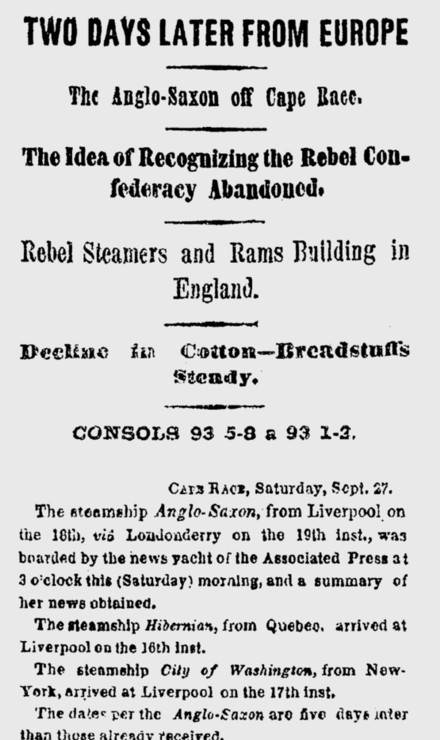
“The Anglo-Saxon off Cape Race”
The steamship Anglo-Saxon on the open ocean
was boarded by the Associated Press at 3am…
New York Times, 28 September 1862
There was a New Moon on 23 Sept 1862. This rendevous between the APyacht and the steamship was performed on the open ocean at night only five days after the NewMoon – thatis, there was very little moonlight even if there was no cloud cover. We do not know what the state of the ocean was – it could have been anything from a calm sea and a light breeze (unlikely) to five-metre waves and a howling gale (also unlikely) or anything in between. This brief meeting, between the Associated Press and a fast transatlantic steamship running on a tight schedule, somewhere off Cape Race, was a routine event that was performed several times times each month, summer and winter, for more than six years. How did they find each other? The APyacht went out to sea, to a position as close to the regular shipping lane as could be managed with the primitive navigation methods then available, and then simply waited until a steamship came along. Remember, this was done when there was no radio, no way to communicate between the two ships other than by flag signals (useless at night) or by flashing lights (with the lanterns then available this was useful only at close range and only when there was nofog, an unusual condition at Cape Race). It is an interesting question: How did they find each other?
The last telegraph cable was laid into Newfoundland in 1953. The Heart’s Content office (then of Western Union) finally closed in 1965. Telephone cable traffic more and more replaced telegraph through the 1960s and 1970s, and that too is now gone. By the late 1990s the only underwater communications cables to operate to Newfoundland were two large fibre optic connections across the Cabot Strait.
Excerpted and adapted from:
The Electric Age
by Ross Peters, Faculty of Engineering and Applied Science, Memorial University of Newfoundland
http://www.engr.mun.ca/~gpeters/eplec1c.html
Laying the Cabot Strait Cable, 1855 by Peter Cooper, president of
the New York, Newfoundland, & London Telegraph Company
http://ns1758.ca/tele/telegraph02.html#cabotcable1855
Laying the Ocean Cable by Peter Cooper, president of
the New York, Newfoundland, & London Telegraph Company
http://www.atlantic-cable.com/Article/CooperOpinions/index.htm
1862 List of Submarine Telegraph Cables manufactured and laid down
by Glass, Elliott and Company, London
This list is organized chronologically, with the earliest cable at the top.
Number six on this list is the 1856 Cabot Strait cable, 85 miles 137 km long.
http://www.atlantic-cable.com/CableCos/BritishMfrs/GlassElliottLetter2.jpg
Richard Atwood Glass Glass, Elliott & Company
History of the Atlantic Cable & Submarine Telegraphy
http://www.atlantic-cable.com/
1858 New York Celebration
After the first messages were transmitted over the Atlantic Cable in August 1858
between Valentia, Ireland, and Trinity Bay, Newfoundland, September 1st was
declared as the official day of celebration in New York City…
(All telegraph messages transmitted across the Atlantic to and from the United
States in 1858 were carried through the Cabot Strait cable between Newfoundland
and Aspy Bay on Cape Breton Island.)
http://atlantic-cable.com/1858NY/index.htm
Transatlantic Telegraph Companies
http://ns1758.ca/tele/telegraph02.html
1897 Atlantic Telegraph Cable Map published by the International Telegraph Bureau, Bern
This map shows Nova Scotia’s central location in the international
telecommunications business in the 1890s (which continued into the 1950s).
http://www.atlantic-cable.com/Article/1869French/BrightMap1.jpg
On Submerging Telegraphic Cables presented to the
Institution of Civil Engineers, London, England, on 16 February 1858
http://www.atlantic-cable.com/Article/1858ICE/index.htm
Wire Rope and the Submarine Cable Industry by Bill Burns
A good description of the earliest (1850-1857) underwater electric telegraph cables.
The first underwater electric telegraph cable was laid across the English Channel
between England and France in August 1850…
http://www.atlantic-cable.com/Article/WireRope/wirerope.htm
Submarine Cable Timeline: 1850-1900 by Bill Glover
http://www.atlantic-cable.com/Cables/CableTimeLine/index1850.htm
Facts and Observations Relating to the Invention of the Submarine Cable
by R.S. Newall, 1882
http://atlantic-cable.com/Books/Newall/index.htm
Cyrus Field and the Epic Struggle to lay the First Transatlantic Cable
Failure Magazine, December 2002
As late as the 1860s the only way to transmit information across oceans
was by ship, which meant weeks of lag time between sender and receiver…
http://failuremag.com/index.php/feature/article/cable_ready/
Atlantic Sentinel by Donald Tarrant
http://www3.nf.sympatico.ca/dtarrant/sentinel.html
Nova Scotia’s Telegraphs, Landlines And Cables by D.G. Whidden, 1938
https://ns1763.ca/tele/whidden2.html
Submarine Cables Making A Comeback 2001
Submarine Cables: A Traditional “High-Tech” Ocean Use
Maritime Affairs magazine
The Naval Officers Association of Canada
Glen Herbert and Scott Coffen-Smout work with the
Oceans Act Coordination Office,
Department of Fisheries and Oceans,
Eastern Scotian Shelf Integrated Management Project
In 1858, Newfoundland and Ireland were connected by telegraph cable…
This article provides a snapshot of the international submarine cable
industry, with a particular focus on the Canadian context…
Marine communications is one of the fastest growing areas of ocean
technology worldwide. Canada’s seabed is being used increasingly
for the laying of submarine fibre-optic telecommunications cables to
all parts of the globe… Owing to their lower cost and longer lifespan,
submarine fibre-optic cables have now largely taken over from satellites as
the principal means of delivering international telecommunications traffic…
http://www.noac-national.ca/article/herbert/oceancables_byglenherbert.html
The Anatomy of Submarine Telegraph Cables
Conductor, Insulation, Inner Jute, Inner Sheath, Outer Jute, Outer Sheath…
http://web.archive.orghttp://www.porthcurno.org.uk/html/submarine.html
Faults in Submarine Telegraph Cables Some of the things that could go wrong…
Poor Splices, Fishing Gear, Anchors, Toredos, Crabs, Sharks, Perished Core…
http://web.archive.orghttp://www.porthcurno.org.uk/html/faults.html
Gutta percha
http://web.archive.orghttp://www.porthcurno.org.uk/html/guttapercha.html
The End of the Transatlantic Telegraph
Transatlantic Telephone Cables, 1956-1990 Wikipedia
http://www.wikipedia.org/wiki/Transatlantic_telephone_cable
A chronology of Telegraph, Telephone and Radiotelephone, the three services
reaching across the Atlantic before the 1960 Echo satellite
by Alan Leon Varney, AT&T Network Systems
http://www.netvalley.com/archives/mirrors/telegraph__radio_timeline-3.htm
The First Transatlantic Telephone Cable, September 1956
http://www.sigtel.com/tel_hist_tat1.html
…One of the first difficulties encountered was in selecting a route for
the two cables required, as the shortest, and perhaps the best, were already
occupied with telegraph cables. In the winter of 1953 suitable sites to land
the cables were chosen in Newfoundland and Scotland. The Scottish site was
a few miles south of Oban, and was linked by an improved coaxial cable line
to carry 900 inland and transatlantic circuits via Glasgow to International
Exchange, London. On the other side of the Atlantic the cables came ashore
at Clarenville, Newfoundland, then crossed the Cabot Strait to Sydney Mines,
Nova Scotia. From Sydney Mines to the US border a line-of-sight microwave
radio link completed the system… Across the North Atlantic Ocean, between
Scotland and Newfoundland, each cable was to be laid in three continuous
lengths complete with repeaters. At the end of June 1955 Monarch laid
200 miles of shore-end cable from Clarenville… By April 1956, all that was left to
install on the North American end was the single cable across Cabot Strait
between Newfoundland and Nova Scotia… In the first 24 hours of public
service there were 588 London-to-US calls and 119 from London to Canada.
This was the start of a substantial increase in the number of calls made.
During the first full week of operation the number of calls to Canada was
85% higher than the average weekly traffic over the radiotelephone circuits;
calls from Canada were 100% higher…
These links were accessed and found to be valid on 9 August 2009, 19 July 2012.
Modern History of the Atlantic Telegraph Cable
Cabot Strait Telegraph Cable Relics
For Sale — January 2007

For Sale, January 2007: Atlantic Cable Relics
Note: The seller billed this as a “Piece of the First Transatlantic
Telegraph Cable”, but my interpretation is different. My view is
that the First Transatlantic Telegraph Cable is the 1858 cable
laid on the floor of the Atlantic Ocean between Ireland and
Newfoundland. These relics are pieces of the 1856 Cabot Strait
cable, not the 1858 cable between Newfoundland and Ireland.
They can accurately be described as an essential part of the
First Transatlantic Telegraph service, but not as part
of the First Transatlantic Telegraph Cable
ICS: 18 January 2007
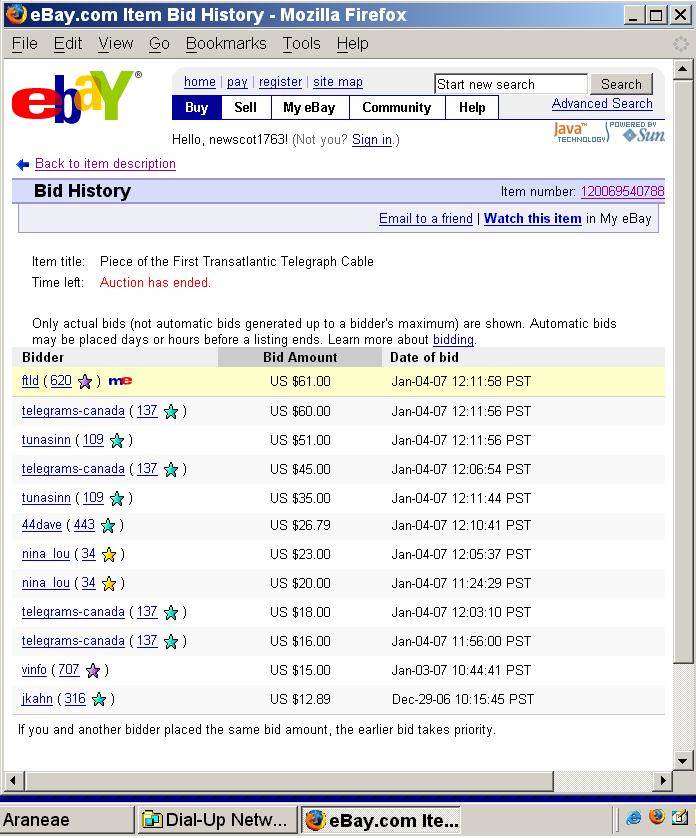
Bidding History, January 2007: Atlantic Cable Relics
This bidding history shows a last-minute flurry of competitive bids,
a scenario often seen in eBay bidding for items that attract the
interest of several buyers. In this case, the auction was
scheduled to close precisely at 12:12:12 PST on 4 January 2007.
This closing time is known to all, and is automatically enforced
by the eBay software, that refuses all bids that arrive after the
closing time. In this case, the auction was open for seven days,
but the final ten bids all arrived during the last 17 minutes.
The final three bids arrived in the last 16 seconds, the interval
between 12:11:56 and 12:12:12. The brief two-second interval
between the last competing bid and the winning bid indicates
that the winning bidder had entered an automatic bid.
(ICS: 22 January 2007, revised 21 May 2007)





